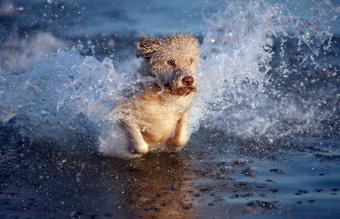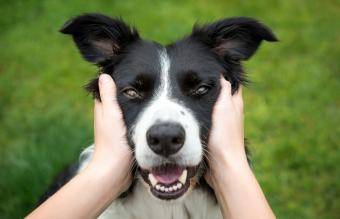
Portuguese Water Dogs -- or just PWDs, for short -- are medium-built dogs that look similar to Poodles due to their thick coats. Though there are written records of the breed as far back as 1297, it was first recognized by the American Kennel Club (AKC) in 1983. These dogs have risen in popularity since 2008, thanks in part to the adoption of Bo and Sunny by the Obama family, the First Family of the United States.
Origin and History
The Portuguese Water Dog originated from dogs used by Portuguese fishermen to assist with retrieving gear from the water, sending messages from boat to boat, and driving fish into nets. There is a common theory that the PWD was developed from the Poodle due to their original duty in Germany as a water retriever.
This breed nearly disappeared in the early 20th century as the traditional fishing industry began to decline, until a wealthy Portuguese man named Vasco Bensaude saved the breed by developing a fan club. A breed standard was developed and the PWD began to appear at dog shows.
Despite the fact that there were only 12 known PWDs in the United States at the time, the Portuguese Water Dog Club of America was founded in 1972. The AKC welcomed the dogs to its Miscellaneous Class, a type of transfer point for breeds awaiting full recognition, which the breed received just 10 years later when their numbers had climbed to 650.
Breed Characteristics
Portuguese Water Dogs come in a variety of temperaments. Some are strong-willed, while others are more laid-back, with the majority falling somewhere in between.

General Appearance
At first glance, a Portuguese Water Dog looks similar to a Poodle due to their profuse coat, but up close, you can see clear differences. According to the AKC standard, male PWDs average between 42 and 60 pounds, while females average 25 to 50 pounds. A male PWD has an ideal height of 22 inches at the shoulder, while females are usually 19 inches tall at the shoulder. This medium-sized breed usually has a muscular build and strong bones.
- With a broad head and a good-sized nose, the PWD sports a muzzle with a definite stop where it meets the skull.
- The forehead is high, and the back of the skull is well curved.
- PWDs have full, dark eyes with a calmly penetrating expression.
- They also have heart-shaped ears that hang close to the skull.
- The muscular neck flows into a broad, deep chest.
- The topline is level.
- The tail is thick at the base and tapers to the tip; it is never docked, and it curves over the back when the dog is alert.
- Webbed feet are one of the most distinctive features of this breed.
The coat of these dogs is one of their greatest assets. The coat grows incredibly thick and provides excellent insulation. It is virtually waterproof and allows them to spend long hours swimming in cold water. It should also be noted that these dogs do not shed, and while it cannot be said that any breed is truly hypoallergenic, many claim that these dogs produce fewer allergic reactions than many other breeds.
PWDs come in two coat varieties, neither of which is favored over the other.
- Wavy: This coat hangs in waves and has a soft shine.
- Curly: This coat produces dense curls, similar in texture to a Poodle.
Colors include:
- Black
- All shades of brown
- White
- Silver
- Parti-color (This is a combination of one of the solid colors and white.)
Temperament
The personality of the average PWD is a wonderful combination of liveliness, common sense, and a willingness to cooperate and please. Bred for endurance, PWDs tend to not be hyperactive and can make wonderful companions for adults and children under the right conditions. They get along well with other dogs and can be trained to accept cats if they are raised with them as youngsters.

One thing potential owners must realize is that PWDs are devoted to their people, and they require a good deal of attention to remain well adjusted. PWDs do not thrive on being left alone most of the day without companionship. Boredom leads to frustration, and frustration can lead to behavior problems.
Training
PWDs love to work closely with human companions, so you will find PWDs train with greater ease than many other breeds. However, these dogs are independent thinkers, which makes it necessary for you to take the leadership position from the beginning. They respond well to positive training methods because they have such a strong desire to please. Harsh reprimands will only slow down the learning process. Portuguese Water Dogs love to participate in nearly any activity, including obedience, agility, retrieving, and other field sports.
Exercise Requirements
Bred to be a working dog, the athletic PWD needs daily exercise and mental stimulation. Plan on taking a walk with your dog every day to help them burn off excess energy. However, much more activity is likely required.
Because these dogs love the water so much, you should take your pet swimming a couple times a week if you can manage it. Barring a full swim, a rousing game of fetch along the shoreline also provides plenty of exercise and stimulation. Playing fetch asks your dog to perform a task, and by giving your dog a job to fulfill, they'll feel more content.

Lack of proper exercise and companionship can lead to destructive behavior, such as tearing up furniture or chewing your belongings.
Health
This fairly robust breed has a few serious health problems that you should be aware of:
- Cataracts: Portuguese Water Dogs are one of the breeds affected by cataracts. These occur when the opacity of the lens affects one or both a PWD's eyes, either partially or completely. Left untreated, it can lead to blindness.
- Dysplasia: This condition causes painful degeneration of the hip and elbow joints.
- PRA blindness: This condition causes atrophy of the retina.
- GM1 storage disease: This condition usually becomes evident around six months of age. It causes nerve damage and is usually fatal because the disease is well under way before it becomes evident.
- Juvenile cardiomyopathy: This hereditary heart condition causes sudden death in puppies.
-
Distichiasis: This disease may appear at any time in a PWD's life wherein the eyelashes unusually grow in the eyelid margin. Ocular irritation is a typical end result of such abnormality.
Lifespan
On average, PWDs live between 10 and 14 years.
Grooming
To prevent matting, make sure to brush and bath these dogs consistently. There are two main trims:
- Lion clip: The muzzle and rear are shaved, leaving the coat hanging long over the rest of the body.
- Retriever clip: This is a utilitarian clip with the entire coat scissored to approximately 1 inch in length. The only exception is the tail.
Fun Facts About the Breed
- They have webbed feet, which is one of the reasons they can swim so well.
- They are often called "porties" for short.
- Porties are known to adapt very well to apartment living, but you must make sure they get enough exercise.
- This breed is quite clingy with their owner.
- The average portie can run 15 to 20 mph.
Purchasing or Adopting a Portuguese Water Dog
If you're looking for a Portuguese Water Dog puppy, a good place to start is the website of the Portuguese Water Dog Club of America (PWDCA). They have a breeder directory available as well as helpful tips on how to find responsible breeders with quality dogs. The AKC Marketplace page also has a breeder search.

The average cost to purchase a purebred Portuguese Water Dog is around $2,000. Add in the cost of registrations, certifications, puppy wellness care, and immunizations, and your initial layout could be much more. There are a few factors that can affect the price of a PWD, including age, breeder, sex, coat, personality, and behavior.
Rescue Organizations
Although Portuguese Water Dogs can be purchased from reputable breeders, there are also a few rescue organizations that are devoted to the breed:
- The PWDCA Rescue and Relocation Program's goal is to find safe and loving homes for all needy PWDs, as well as assisting PWD owners in dealing with training issues.
- Rescue Me! Portuguese Water Dog Rescue helps give PWDs a second chance by locating a happy home for them.
- Southern California Portuguese Water Dog Club visits shelters in an effort to rescue Portuguese Water Dogs, Poodles, and mixed breeds.
Is a PWD Right for You?
Portuguese Water Dogs are wonderful pets for the right people. If you are prepared for the challenge of living with a large and energetic dog who requires regular grooming, you just may find that this wonderful dog makes the perfect addition to your household.







